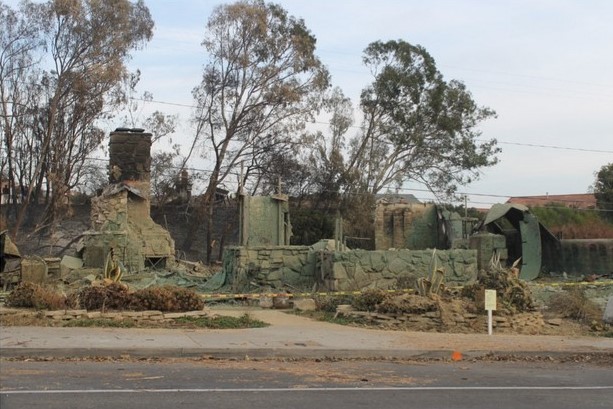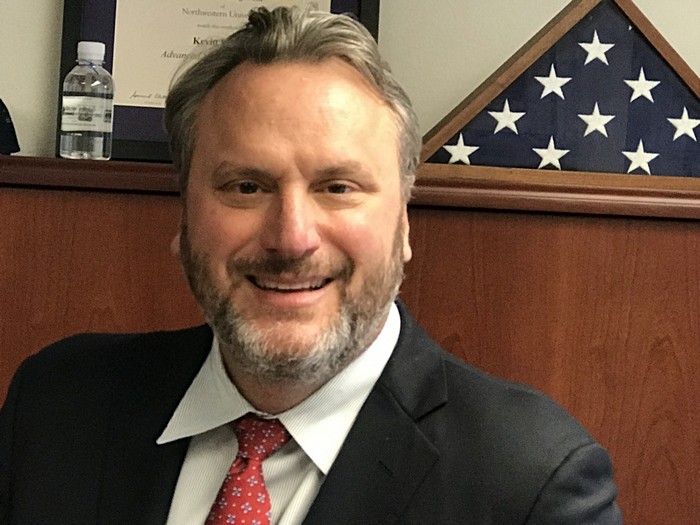Brown had been on the job only 2 months when the Thomas Fires erupted.
by Jennifer Tipton
Before becoming Ventura Water’s General Manager, Kevin Brown, now a retired Navy Captain, worked in the Pentagon as chairman of the Strategic Laydown Assessment for the Chief of Naval Operations, a nine-billion-dollar annual program.
With an annual revenue of around $94 miilion, Ventura Water brought in Brown specifically for his strategic planning experience for infrastructure. He had been on the job only 2 short months when the Thomas Fires erupted.
On that fateful night, December 4th, 2017, Brown was at City Hall with most of the city staff for the initiation of Mayor Neal Andrews. “We were getting ready to celebrate our new mayor when phones started blowing up”, said Brown. Grabbed to the Emergency Operation Center (EOC) he was still so new to the job, he was just happy to be told we had one! In the Navy, they would routinely practice drills, but according to Brown, “for a city that had not had to do this for a very long time, the response was tremendous, all of the city came together quickly and that was impressive!”.
I asked, “are you aware some have asked where was the water when we needed it most? Do you feel we had enough water to combat the Thomas Fires?”
Brown assured me that there was ample water supply, “more than enough with what was brought in from Lake Casitas”. I then asked if there was a problem with the fire hydrants and he responded, “no, however, there were large water tanks we just couldn’t get to because they were surrounded by fire”.
He spoke of drought and disaster resiliency, “we’re constantly analyzing the system to see where it can be improved, such as, how homes are built and the utility systems – do they need to be changed? The Oxnard City Water Services has over 400,000 customers, they are worried about being cut off by a seismic event, we’re all looking at that”.
There are four water basins we draw from here in Ventura and four different organizations that oversee those basins, “it’s complicated”, said Brown.
According to Craig Jones with Ventura Water, the basins and the organizations that oversee them are:
- Mound Basin – Mound Basin Groundwater Sustainability Agency
- Oxnard Plain – Fox Canyon Groundwater Management Agency
- Upper Ventura River – Upper Ventura River Groundwater Sustainability Agency
- Santa Paula – Santa Paula Basin Technical Advisory Committee (TAC)
“Since 1971, Ventura has been paying for state water but never got it, because there’s no connecting pipeline”, said Brown, “this should be completed by 2022 – 2023”.
I discovered that what we’ve been paying for is the right to state water and we pay roughly $1 million per year; water delivery fees will be an extra cost once the pipeline is complete.
In Fall 2018 – Fall 2021, Advanced Metering Infrastructure (AMI) will be in place. Ventura Water will be replacing all manually read meters with automatic meters that relay readings remotely. The expected results are improved accuracy in readings and customer service, advanced leak detection and notification capabilities, the ability for customers to actively manage their water usage and enhanced water quality protection and conservation. Ventura Water is excited to implement this new technology.
Lastly, I asked Brown, “if you knew what was coming (Thomas Fires) would you have taken the position as General Manager with Ventura Water?” He sat back and chuckled, “oh boy… knowing then what I know today … yes, I would. It’s in my heart as an engineer and there’s so much going on here from water allocations to all the innovations, it’s just exciting each day to come to work!”
Ventura Water will be looking at revenue and rate structure changes starting winter 2018.





